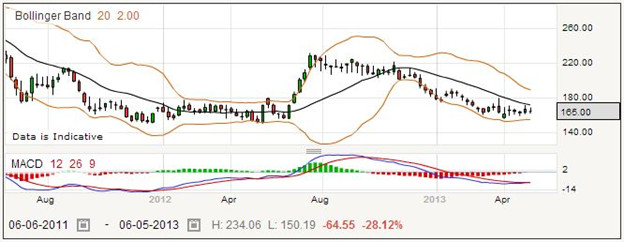There are several different varieties of wheat grown, and also several different markets that can be spread bet on – the regular futures markets are based in London, Paris, and Chicago, and further types of spread bets are available on the exchange traded commodity (ETC). The chart below is for ETC wheat, which allows the greatest variety of bets, including the rolling daily and three futures style bets.
While the values will change, the different markets would tend to track in the same way, and can be looked on as similar from the point of view of analysis.
Wheat is used for several different things, including flour for food, livestock feed, brewing, and for gluten production. Unlike some other commodities, such as oil, for different purposes there are alternatives to wheat, including soybeans and other grains, though these are not direct substitutes for each other. Your research on the prospects for wheat production, and therefore how the markets will be impacted by the supply, can include the prospective plantings report which is usually issued around March, at the beginning of the season. During the season, you can also find monthly crop production reports which update the expected supply and demand for wheat.
As an agricultural product, you can expect the prices to vary seasonally, falling at the start of the year and usually increasing towards the end. This is the expected tendency, but as you can see from the weekly price chart above it is by no means certain. The monthly production reports, which are issued on the 10th by the USDA, can be expected to have a noticeable impact on prices when issued, which you must take into account if you have an open position at that time. The weather can play a significant part in determining the value, as can the various crop diseases as they are revealed.
Wheat Rolling Daily
Taking ETC wheat prices as an example say that you are bullish on wheat and want to place a long bet. The current quote for a daily rolling bet is to sell at 164.59 and buy at 165.41, so your bet would go on at 165.41. In view of the relatively low price, you decide to wager as much as £15 per point.
As an example, assume that the price goes up to 192.59 – 193.41, at which point you decide to take your profit and close the bet. That means that you opened the bet 165.41 and closed it at 192.59, a gain of 27.18 points. If you multiply this by your stake of £15 per point, your winnings work out to £407.70. With a rolling daily bet your account may be charged fees each evening when the bet is rolled over. Given a fairly active price chart, these are usually not significant.
If your spread bet didn’t work out, then you might choose to close a losing position if the quote drops to 150.59 – 151.41. Your bet would close at the selling price of 150.59. Taking this away from the opening price of 165.41, you would have lost 14.82 points which for your size of stake amounts to £222.30.
Many spread traders decide to use a stop loss order to protect them from inordinate losses. The stop loss order requires your spread betting provider to close your trade once it reaches a certain level of loss, and you do not have to be watching the market all the time. With a stop loss order, this trade might have closed when the quote was 156.19 – 157.01, saving some of your loss. With an opening price of 165.41 and a closing price of 156.19, this time you would have lost 9.22 points, which with a stake of £15 per point would cost you £138.30.
Wheat Futures Style Bet
Continuing with the example of ETC wheat, although you can also spread bet on different futures markets for wheat, the current price for the far quarter bet is 164.70 – 166.69. Suppose this time you take a short position, with a sell bet placed at 164.70 for a stake of £12 per point.
Once again, consider first a winning bet. Suppose the quote goes down to 122.70 – 124.69. If your analysis suggests that this is about as far as the price will go, you should close it for a win. The closing price will be 124.69. Taking 124.69 away from 164.70, you would have gained 40.01 points. With a stake of £12 per point that amounts to a profit of £480.12.
Even though you have placed a futures style bet which is not due to expire for many months, you can close it at any time, for example if the price goes against you. You might want to close the bet to cut your losses if the quote goes up to 178.70 – 180.69. Your closing price would be 180.69, so with a starting price of 164.70 your losses amount to 15.99 points. With the same stake of £12 per point, that means you would have lost £191.88.
If like many people you do not have the time or inclination to watch the markets all day long, you should consider using a stop loss order which you place at the time of your initial order. This requires your spread betting provider to close your losing bet if it reaches a price that you set. Suppose a stop loss order in this case is activated and closes when the quote was 173.10 – 175.09. This time your closing price would be 175.09, which means that your losses would be kept down to 10.39 points. Multiplying by your stake, the cost to you would be £124.68.
